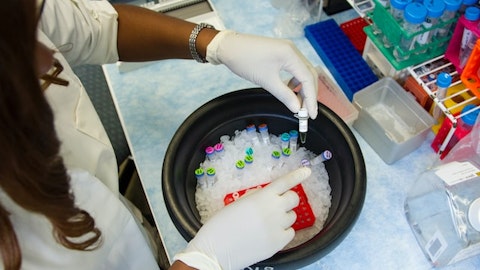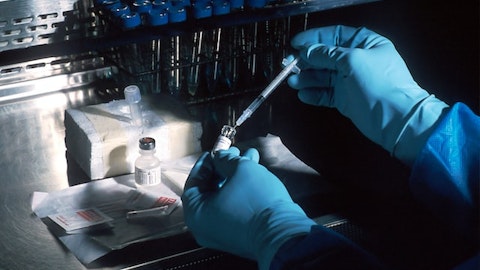Biora Therapeutics, Inc. (NASDAQ:BIOR) Q3 2023 Earnings Call Transcript November 13, 2023
Biora Therapeutics, Inc. misses on earnings expectations. Reported EPS is $-4.89 EPS, expectations were $-0.93.
Operator: Greetings and welcome to the Biora Therapeutics Third Quarter 2023 earnings call. At this time, all participants are in a listen only mode. A brief question-and-answer session will follow the formal presentation. [Operator Instructions]. As a reminder, this conference is being recorded. It is now my pleasure to introduce your host, Chuck Pedala, Managing Director with LifeSci Advisors. Thank you, Chuck, you may begin.
Chuck Pedala: Thank you, operator. Good afternoon and welcome to the Biora Therapeutics Third Quarter 2023 Corporate Update and Financial Results Conference Call. Joining me on the call are Adi Mohanti, Chief Executive Officer; Eric d’Esparbes, Chief Financial Officer. Before I turn the call over to Mr. Mohanty, I would like to remind you that today’s call will include forward-looking statements within the meaning of the federal securities laws, including but not limited to the types of statements identified as forward-looking in our quarterly reports Form 10-Q that we’ll file later today in our subsequent reports filed with the SEC, which are available on our website in the investor section. These forward-looking statements represent our views only as of the date of this call, potential risks and uncertainties, including many that are beyond our control.
Please note the actual results could differ materially from those expressed in the forward-looking statements. For a further description of the risks and uncertainties that could cause actual results to differ materially from those expressed in the forward-looking statements, as well as risks related to our business, please see the company’s periodic reports filed with the SEC. With that, I will now turn the call over to Adi Mohanty, CEO of Biora Therapeutics.
Adi Mohanty: Thanks, Chuck, and thank you, everyone, for joining us. During the third quarter, we continued to make excellent progress with both of our platform technologies. The NaviCap platform is rapidly advancing towards initiation of a Phase 1 clinical trial by year end, and development of the BioJet platform has accelerated with an increased pace of data generation from several molecules, including those of our pharma collaborators. First, an update on our NaviCap targeted therapeutics platform with our lead program, BT-600 in ulcerative colitis. Research suggests there is a minimum level of drug needed in the tissue at the site of disease to achieve better therapeutic outcomes in ulcerative colitis or UC. Our technology can potentially increase tissue concentration without systemic toxicity, which could provide improved outcomes for UC patients.
We hope to demonstrate this with a Phase 1 clinical trial, which we are on track to initiate by end of this year. Earlier, we filed our IND application with the FDA as planned. The IND for BT-600 includes extensive manufacturing, preclinical, and toxicology data, as well as clinical device function data from our four separate studies in both healthy volunteers and UC patients. So that’s a sizable filing that includes over 300 documents larger than a typical submission, because we have both drug and device information. The FDA often generates questions and requests information as they review these types of filings. Towards the end of the FDA review period, we received some question that required us to provide additional information, which we have.
We discussed the questions with the agency, and as a result of our conversation, it became clear that it was appropriate for us to refile — which we did. This allows the FDA to have additional time to review our application and the additional information. We continue to have a constructive dialogue with the FDA, and it’s understandable that the extensiveness of the information supporting our R&D would require additional time for review. We hope the review will be satisfactorily completed by the end of this month. If so, we anticipate maintaining our timeline to initiate a Phase 1 trial before the end of this year. We are, to our knowledge, the first company to file an IND for a drug and ingestible device combination. While other companies have pursued clinical studies that’s outside the US, we believe it’s important to engage US regulators as early as possible as it takes the most rigorous path to approval.
We’ve successfully completed four human studies in which the NaviCap device performed as designed across a range of expected differences in GI motility in both healthy volunteers and UC patients. The next step is to use the NaviCap device to deliver to upper segments. We aim to prove our treatment hypotheses by confirming that we can achieve sufficient drug levels in the colon tissue along with low systemic exposure. We anticipate exiting Phase 1 with not only safety data, but also with critical data on potential exposure in both plasma and tissue, which would be much more informative than a typical Phase ` trial. In addition to progressing towards Phase 1, we continue to expand our intellectual property coverage for the NaviVap platform. Recently, we received notice of allowance of a new patent that encompasses the novel treatment paradigm of our BT-600 program with its this targeted delivery of JAK inhibitors to the GI tract.
We will share more details in the coming weeks when the patent issues. Earlier this year, we were awarded another group of US and European patents that expanded our coverage for additional therapeutic targets for UC. We hold one of, if not the world’s most comprehensive IP portfolio for drug delivery using ingestible devices with 30 patent families for the NaviCap platform alone. As we progress our UC program, we gain more data on the overall platform, and the combination of IP and platform development will allow us to expand our pipeline organically with additional programs. Moving on to our BioJet systemic therapeutics platform. Our goal with the BioJet platform is to provide needle-free oral delivery of therapeutic molecules. The BioJet platform is based on a small capsule that, once swallowed, is designed to deliver drug into the wall of the small intestine using liquid jet injection.
We believe the BioJet platform can provide an alternative to needle-based delivery of complex molecules, and could also enable those molecules to more efficiently reach the liver for delivery into the small intestine. As planned, during Q3, we continued development and testing to confirm the performance of our next-gen BioJet 2 device, which allowed us progressed further and began testing our pharma collaborators’ molecules with the device. In October, we presented new data at the European Association for the Study of Diabetes, so we confirmed that our BioJet 2 device exceeded its performance targets. Across three studies, in a porcine model, 96% of animal showed semaglutide, its systemic circulation at clinically relevant levels, for up to 10 days following administration.
Among the 22 animals dosed with semaglutide, oral bioavailability averaged 20.5%, which exceeds both the device performance and bioavailability targets set by us and our collaborators. Data analysis from animal studies were also completed with one of our collaborators’ molecules to demonstrate the potential of the BioJet platform to achieve uptake of large molecules into the liver. Many disease targets reside in the liver, and it’s a key area of focus for RNA-based therapeutics, such as antisense oligonucleotides, or SI RNA-based drug. Large molecules must typically be delivered via IV or subcu injection because they cannot survive the stomach acid, and are too large for absorption through the small intestine. The challenge with IV or subcu delivery is most of the drug is metabolized before it reaches the liver.
Our technology uses liquid jet injection into the small intestine, which is an optimal delivery pathway to the liver. So the BioJet platform to provide a unique advantage for liver targeted oral delivery of large molecules. While we aren’t clear to share data yet, I can say that the results of the study with our collaborator’s molecule were extremely encouraging. We also recently completed another set of animal studies for a second collaborator, and are in the process of having the hundreds of samples analyzed. These data will provide further support for the BioJet platform’s ability to deliver large molecules. In addition, we’re initiating preclinical studies with a pharma collaborator. As we continue the progress of the budget platform and produce further data, we have seen increasing interest from potential partners, and we’re actively negotiating an agreement with a potential pharma collaborator.
It is common for research collaborations to have strict confidentiality requirements early on, particularly those involving very large companies and highly competitive drugs. We appreciate the need to share as much information as possible with our stakeholders, but we rely on our collaborators’ permission and timing to share information. We’ll continue to be as transparent as possible, while being good partners and respecting the disclosure rules established with our collaborators. We believe we are well positioned with the BioJet platform several advantages — its ability to achieve category-leading bioavailability of complex molecules — its ability to deliver existing liquid formulations and large payloads in the multi milligram range, and its potential to enable liver-targeted delivery of large molecules.
We’re excited to see the accelerating development of the BioJet platform, and we look forward to sharing more about the progress with our existing and new collaborators and potential partner. To summarize our anticipated milestones, for our NaviCap platform, we await the FDA’s response to our NDA application, and we anticipate initiating our Phase 1 trial before the end of the year. Initial Phase 1 data is anticipated early next year, and if we begin the trial before the end of this year as planned, we expect to complete the execution of the trial in Q1 with final data coming after that. For our BioJet platform, we expect to continue generating data from animal studies with the molecules of our pharma collaborators during the fourth quarter.
With three existing and potentially a fourth new collaboration, all generating data that adds to the overall development dataset of the platform, we anticipate accelerating interest from others With that, I will now turn the call over to Eric for a review of our financial results and capital market activities.
Eric d’Esparbes: Thanks, Adi, and good afternoon, everyone. We had a number of financial activities during the third quarter. We made significant progress on optimizing our capital structure by materially reducing our convertible note balance by $50 million through the notes exchange agreement. We remain actively engaged with convertible note holders to further enhance our capital structure to be more aligned with our company profile. I’m happy to share that we’re making progress to further reduce that our convertible note balance through a new potential note exchange, with the possibility to generate additional funding for the company. We expect to have further announcement on this in the near term. As a result of those activities, we have some non-recurring and non-cash entry in our Q3 financial results, which I will explain in more detail.
Operating expenses were $23.3 million for the first three months ended September 30, 2023, compared to $14.9 million for the three months ended June 30th, 2023. The increase was mainly attributable to a one-time stock-based compensation, non-cash charge of approximately $9 million related to vesting of employees’ restricted stock units. As a result, operating expenses, excluding stock-based compensation expenses, effectively remained stable at $12.8 million with continued investment in device development, preclinical studies, and IND-enabling activities. Breaking this down, G&A expenses in the third quarter were $6.9 million excluding stock-based compensation expenses, while R&D expenses in the third quarter were $5.9 million also excluding stock-based compensation expenses.
We continued to streamline our G&A expenses and are making good progress in focusing our investments on R&D programs. While legacy spend has substantially been reduced over the last few quarters, it still represented more than 30% of our G&A cash spend in Q3, and we continue working actively to reduce it going forward with further substantial changes by early next year. Our core OpEx spend remains focused on our R&D programs as we rapidly move towards the clinic. We maintain our guidance of an average monthly operating cash burn of approximately $4 million. Net loss for the quarter was $73.5 million. This includes non-cash charges to stock-based compensation expenses of $9 million noted earlier, and a non-cash charge of $53.2 million attributable to the convertible note exchange implemented by the company in September.
As a result, our effective operating cash burn for the quarter was $12.7 million. On the fundraising front, we successfully raised almost $6 million in gross proceeds through different sources since our last call. We successfully monetized some remaining legacy assets, including our Ann Arbor lab building. We continue to target non-dilutive sources of funding, and actively engage with the investor community to ensure access to the necessary capital needed to fund the development of our programs. We’ve also seen keen interest from investors in supporting our programs through direct capital investments in Biora, and we’ve already raised meaningful capital through that channel so far this quarter. With that, I will now turn the call back over to Adi.
Adi Mohanty: Thanks, Eric. Biora continues to make strides with both our NaviCap platform, where we are focused on entering the clinic with our BT-600 program and our BioJet platform where we’re focused on progressing our pharma collaboration. We look forward to providing further updates as we achieve our milestones. Operator, we’re now ready for questions.
Operator: [Operator Instructions]. One moment please while we poll for questions. Our first question is from Joe Pantginis with H.C. Wainwright.
See also 11 Cheap Solar Stocks To Buy According To Analysts and 10 Healthcare Focused Hedge Funds and 10 Top Stock Picks.
Q&A Session
Follow Biora Therapeutics Inc. (NASDAQ:BIOR)
Follow Biora Therapeutics Inc. (NASDAQ:BIOR)
Joe Pantginis: Hey, guys, good afternoon. Thanks for taking the question. So first question on the BT-600 IND. Was this more of just providing more understanding and clarification in your answers? Or is there anything rate limiting in the answers and responses expected with regard to getting the study started?
Adi Mohanty: Yes, Hi, Joe. So I think we mentioned in the script that the FDA asked some clarifying questions, and several of them were related to our device, and you know, about the early development of the device. We had the information, and so which is why we were able to provide that and turn it around within a few days. And so, at this point all the information is back. We hope that the FDA is quickly finishing the rest of their review.
Joe Pantginis: No, that’s great. Thank you. I guess for both programs, but also for BT-600 and beyond for NaviCap, sort of the continuum of manufacturing. Where do you stand right now with regard to being able to supply all the patients for the Phase 1 program and any potential near-term needs for that as well as the BioJet program?
Adi Mohanty: Yes, good question. So for BT-600, along with this review, we’re doing everything on our end that we can control to get ready for a Phase 1 trial, which means getting our sites ready, getting our partners, the CROs ready, doing everything we can including doing supply. So we have already produced what we expect to use for the Phase 1 trial. So, we’ll be ready with the site, the protocols, the supply, everything ready to go for the BT-600. Slightly different for BioJet. We don’t really need to make a lot of these at this point, even though we use 10, 20 different animals and a few doses — it is still only a handful of devices, and we’re able to make those on an ongoing basis. We’re making some great progress with multiple studies coming back to back to back ,but it’s still a very manageable number of devices, and we’re able to easily make those and continue progressing our programs.
Joe Pantginis: Great. Thanks for the color.
Operator: Our next question is from Julian Harrison with BTIG.
Julian Harrison: Hi. Thank you for taking my questions. I guess some more on the IND resubmission. Can you talk more about the expected timeline to turn this around? Is this standard 30 days — something longer, something shorter? And then also do you plan to press release first human dose?
Adi Mohanty: Hi, Julian. So in terms of the review, you know, we very much appreciate that the FDA’s workload, you can imagine, has been already busy. They’ve had a lot to do, and that’s also apparent from some other places where they’ve needed more time. They don’t have a great mechanism for adding time to the 30-day cycle, which is what we were kind of talking about that look towards the end of the cycle when they had these questions, even though we only needed a couple of days to gather the information, turn it around, it would have ended with the 30 day clock running out. And so the best thing to do was to to resubmit. So the resubmission was more of a just a tactical — let’s just go ahead and provide the information, resubmit — and it goes back now into a standard 30-day clock.
So what we hope is that they finish their review very quickly and that in November, we get a clearance from the FDA. And that’s how we’re preparing. We’re preparing — given the interaction we’ve had — they’ve been great. We appreciate the way they’ve worked with us. We’ve had several conversations. And so we hope that they’ll finish the review. We expect that we get a clearance in November, which is why we’re doing everything prepare for start of trial in December.
Julian Harrison: Thanks very much.
Operator: Our next question is from John Vandermosten with Zacks.



